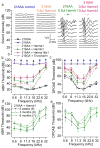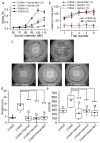Gene therapy restores auditory and vestibular function in a mouse model of Usher syndrome type 1c
- PMID: 28165476
- PMCID: PMC5340578
- DOI: 10.1038/nbt.3801
Gene therapy restores auditory and vestibular function in a mouse model of Usher syndrome type 1c
Abstract
Because there are currently no biological treatments for hearing loss, we sought to advance gene therapy approaches to treat genetic deafness. We focused on Usher syndrome, a devastating genetic disorder that causes blindness, balance disorders and profound deafness, and studied a knock-in mouse model, Ush1c c.216G>A, for Usher syndrome type IC (USH1C). As restoration of complex auditory and balance function is likely to require gene delivery systems that target auditory and vestibular sensory cells with high efficiency, we delivered wild-type Ush1c into the inner ear of Ush1c c.216G>A mice using a synthetic adeno-associated viral vector, Anc80L65, shown to transduce 80-90% of sensory hair cells. We demonstrate recovery of gene and protein expression, restoration of sensory cell function, rescue of complex auditory function and recovery of hearing and balance behavior to near wild-type levels. The data represent unprecedented recovery of inner ear function and suggest that biological therapies to treat deafness may be suitable for translation to humans with genetic inner ear disorders.
Conflict of interest statement
A patent #00633-0203P01 on “Materials and methods for delivering nucleic acids to cochlear and vestibular cells” has been deposited by L.H.V., G.S.G. & J.R.H. The Anc80L65 vector is patented by L.H.V., patent #WO/2015/054653 – “Methods of predicting ancestral virus sequence and uses thereof. L.H.V. is co-founder and SAB member of GenSight Biologics and consultant to various gene therapy companies. LHV receives research support from Selecta Biosciences and Lonza Houston on Anc-AAV development and discovery.
Figures







Comment in
-
Hearing in the mouse of Usher.Nat Biotechnol. 2017 Mar 7;35(3):216-218. doi: 10.1038/nbt.3815. Nat Biotechnol. 2017. PMID: 28267741 Free PMC article.
References
MeSH terms
Substances
Grants and funding
LinkOut - more resources
Full Text Sources
Other Literature Sources
Medical
Research Materials

